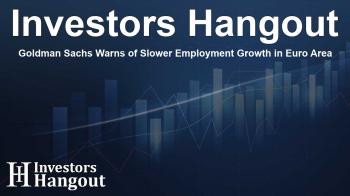Goldman Sachs Warns of Slower Employment Growth in Euro Area

Goldman Sachs Highlights Employment Growth Slowdown
Goldman Sachs recently shared insights regarding the employment landscape in the euro area, signaling a potential decline in job growth leading up to 2025. Their analysis is based on a nowcasting framework that highlights signs of moderation in employment advances, particularly as we approach the end of the year.
Key Factors Influencing Employment Trends
According to Goldman Sachs, several crucial factors are influencing this trend. One of the primary contributors is the tapering off of the strong hiring momentum that was previously supported by low real labor costs. As this hiring boost wanes, there is an expected return to the typical relationship between GDP growth and employment figures.
Forecasts for GDP and Employment
Goldman Sachs has revised its GDP outlook downwards, suggesting that net hiring could face a slowdown by the middle of 2025. Their forecasts indicate that employment growth might dwindle to a mere 0.05% by the end of the year, underscoring a significant departure from previous growth patterns.
Demographic Shifts Impacting Labor Supply
Beyond mere economic figures, demographic changes are also expected to play a pivotal role in shaping the labor supply in the euro area. Specifically, challenges stemming from a shrinking native population are anticipated to offset with gradual increases in the participation rate.
Role of Immigration in Labor Supply
While the native workforce may diminish, Goldman Sachs anticipates that immigration will continue to be the main catalyst for labor supply growth in the upcoming years. However, they predict that immigration flows may decline, estimating a quarterly growth in labor supply to reach 0.09% by the end of 2025.
Future Outlook for the Labor Market
Despite the various trends pointing to potential declines in employment, Goldman Sachs projects that the labor market will maintain a balanced state for the following quarters. They foresee a relatively modest increase in the unemployment rate, aligning with household sentiments that hint at a mild uptick in joblessness.
Risks of Unemployment Rate Increase
However, it's important to acknowledge that there are risks indicating a more pronounced rise in unemployment. If the rate at which individuals find jobs decreases significantly, this could lead to an equilibrium unemployment rate that surpasses current levels. Additionally, insights from the Beveridge curve, which captures the relationship between job vacancies and unemployment, suggest that a softening labor demand might result in job losses.
Conclusion
In summary, the outlook presented by Goldman Sachs on the euro area labor market paints a cautious picture. Factors influencing employment growth, such as changes in GDP expectations and demographic challenges, combined with immigration forecasts, suggest that while the market may remain balanced for now, significant risks could emerge in the near future.
Frequently Asked Questions
What does Goldman Sachs predict for employment growth in the euro area?
Goldman Sachs predicts a slowdown in employment growth through 2025, potentially resulting in growth as low as 0.05% by year-end.
What factors contribute to the expected decline in job growth?
The decline is influenced by the end of strong hiring driven by low labor costs and a change in the relationship between GDP growth and employment.
How will immigration impact labor supply in the euro area?
Immigration is projected to be the primary driver of labor supply growth, although a decrease in immigration flows is expected.
What demographic challenges are facing the labor market?
The labor market faces challenges from a decreasing native working-age population, balanced out by rising participation rates.
Will the unemployment rate rise in the near future?
Goldman Sachs expects only a modest increase in unemployment; however, risks are present for a more significant rise if job vacancies decline.
About The Author
Contact Hannah Lewis privately here. Or send an email with ATTN: Hannah Lewis as the subject to contact@investorshangout.com.
About Investors Hangout
Investors Hangout is a leading online stock forum for financial discussion and learning, offering a wide range of free tools and resources. It draws in traders of all levels, who exchange market knowledge, investigate trading tactics, and keep an eye on industry developments in real time. Featuring financial articles, stock message boards, quotes, charts, company profiles, and live news updates. Through cooperative learning and a wealth of informational resources, it helps users from novices creating their first portfolios to experts honing their techniques. Join Investors Hangout today: https://investorshangout.com/
The content of this article is based on factual, publicly available information and does not represent legal, financial, or investment advice. Investors Hangout does not offer financial advice, and the author is not a licensed financial advisor. Consult a qualified advisor before making any financial or investment decisions based on this article. This article should not be considered advice to purchase, sell, or hold any securities or other investments. If any of the material provided here is inaccurate, please contact us for corrections.

